Origins of the Investigation
The incident began at the end of 2020, on a cold Canadian night, when convenience store owner Ray was tallying up the day's earnings, which included some two-dollar coins affectionately known in Canada as "Toonies". This name stems from the one-dollar coin, called the "Loonie", due to its depiction of the loon, a bird that is a Canadian symbol. When Canada introduced the two-dollar coin, logically, it was dubbed "Toonie", a playful take on "two-Loonies". But let's refocus on our main subject. The Toonies in Ray's possession were noticeably different from the genuine ones in several aspects:
- Design Details: The genuine two-dollar coin features a precisely proportioned polar bear, whereas the fakes, especially the "Big Toe Bear" version, display a bear with disproportionately large toes, a detail far from the original design.
- Font Size and Clarity: The fake coins exhibit significant differences in font size, shape, and clarity, including some inscriptions mistakenly rendered as "Elizabeth 1+1" instead of "Elizabeth II".
- Metal Texture and Weight: Unlike the authentic coins, which are made from a specific alloy using advanced and consistent manufacturing processes, the fakes have an inconsistent weight and texture, feeling either too light or too heavy.
- Portrait Accuracy: Genuine Toonies should bear a portrait of Queen Elizabeth II, but some fakes feature a shrunken old man's image instead.
Epidemic of Fake Coins
Prompted by these discrepancies, Ray decided to alert the authorities. However, it appeared these fake coins were not created with political motives in mind. The Toronto police initially thought it might be a prank by some bored individuals. The matter seemed minor until the COVID-19 pandemic hit. Pandemic precautions led many stores to refuse cash, significantly reducing the demand for change and leading many businesses to deposit their cash, including a large number of coins, in banks. This process uncovered an increasing number of counterfeit coins.
By July 2021, the Toronto Police had received over seventy fake two-dollar coins, and this number only continued to grow. While the face value of the discoveries might seem trivial, the implications were far-reaching. Counterfeiters likely produced these fakes in large quantities to recoup their investment, suggesting that the seventy discovered coins barely scratched the surface. The police launched a significant investigation, forming a special task force to thoroughly search the city, with a particular focus on places where transactions commonly involve small denominations, such as casinos, gas stations, and other similar venues.
As expected, they discovered thousands of similar fake coins. As the investigation expanded, a more astonishing fact came to light —banks had a mix of genuine and fake coins! How did these fake coins infiltrate the banking system so extensively?
Here is a simple answer. For convenience, banks had customers roll their coins before depositing them. These rolls were only randomly checked and weighed, making it nearly impossible to spot the few fakes hidden within each roll. Once these coins were repackaged and redistributed, they re-entered circulation, now bearing the bank's implicit stamp of authenticity. A routine audit of several banks revealed nearly all contained traces of counterfeit coins, with one extreme case finding over half of the coins in a single roll to be fake.
This discovery prompted a nationwide alert and brought into question the effectiveness of current verification methods used by banks and businesses alike. The sheer volume of fake coins discovered suggested that this wasn't just a local issue but a widespread problem affecting millions of Canadians, most of whom unknowingly possessed and used these counterfeit coins in their daily transactions.
Unmasking the Counterfeit Operation
Investigations revealed that these counterfeit coins had likely been in circulation since around the year 2000, suggesting a long-term, well-orchestrated operation that had managed to fly under the radar for years. Experts estimate that at least 5% of all two-dollar coins in Toronto and its surrounding areas are fake, indicating the presence of millions, possibly tens of millions, of counterfeit coins across Canada.
The psychological impact of the two-dollar coin, often overlooked due to its small denomination, played a significant role in the success of this counterfeit operation. The general public, accustomed to scrutinizing higher-value notes, rarely gave a second thought to the authenticity of their coins. This complacency, exploited by the counterfeiters, allowed fake coins to circulate with ease for years.
The revelation of such a vast network of counterfeit coins prompted investigations by national security agencies, considering the possibility of foreign involvement aimed at undermining Canada's financial system. However, the source and motivations behind this operation remain shrouded in mystery.
In response, Canadian police and the Canadian Security Intelligence Service (CSIS) conducted extensive investigations and strengthened regulatory and review mechanisms, especially regarding the procedures banks and commercial institutions use to handle two-dollar coins. Additionally, the Royal Canadian Mint enhanced its anti-counterfeiting technology, particularly in coins issued after 2012, by introducing advanced security features such as finely engraved laser-cut maple leaf designs, significantly reducing the circulation of counterfeit coins.
Enhancing Security and Efficiency in Cash Transactions
It's important to note that counterfeit bills and coins are equally prevalent, and businesses should also pay attention to the necessity of equipping themselves with banknote counter machines and coin counter machines that possess advanced counterfeit detection capabilities. This not only prevents economic losses but also improves the efficiency of daily cash reconciliation.
This incident serves as a stark reminder of the complexities of modern counterfeiting and the continuous need for advanced security measures in currency production. It also highlights the importance of public awareness and the role of individual vigilance in combating such sophisticated criminal endeavors.







